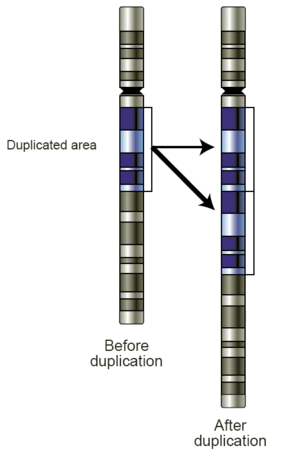Gene duplication facts for kids
Imagine a special instruction book inside you called DNA. A 'gene' is like one important instruction in that book. Gene duplication happens when a part of this instruction book, including a gene, gets accidentally copied. This copying might sound like a mistake, but it's actually super important for how living things change and grow over a long time – this is called evolution. Scientists have known about this since the 1930s. Today, we know that duplicated genes are very common in almost all living things!
Contents
How Genes Get Copied
How does this copying happen? Sometimes, when cells are making new copies of themselves (a process called meiosis), the chromosomes (which hold your DNA) don't line up perfectly. This can lead to a mistake called 'unequal crossing-over'. It's like when you're copying a page, and you accidentally copy a section twice. This can create an extra copy of a gene.
Another way it can happen is through 'jumping genes' (scientists call them retrotransposons). These are bits of DNA that can move around and sometimes make copies of themselves, inserting the copies into new places in the DNA.
Why Gene Duplication Matters
When a gene gets copied, there are now two copies of the same instruction. The original gene still does its job, so the organism is fine. But the second copy is often 'free' to change. This means that if mutations (small changes) happen in the second copy, they usually don't hurt the organism. Because of this, the copied gene can collect mutations much faster than the original gene.
This freedom allows for new things to happen!
- New functions: Sometimes, these mutations can lead to the copied gene doing something completely new. This is how new features or abilities can appear in living things over many generations.
- More of the same: Other times, the copied gene might just make more of the same protein, which can also be helpful for the organism.
Gene duplication is like having a spare part that you can experiment with without breaking the original machine. If the experiment works, you've improved the machine!
Gene Duplication and Evolution
Many scientists believe that gene duplication is one of the most important ways that evolution happens. A famous scientist named Susumu Ohno wrote a book about this in 1970, saying it was key to how life has changed since the very first living things appeared.
Big copying events, where an entire genome (all the DNA in an organism) gets duplicated, are not rare. For example, it's thought that the entire yeast genome was copied about 100 million years ago. Plants are especially good at this! For instance, wheat is 'hexaploid', meaning it has six copies of its entire genome.
After a gene duplication, the two genes are called paralogs. They usually make proteins that are similar in what they do or how they are built. On the other hand, orthologous genes are similar genes found in different species, which came from a shared ancestor before the species split apart.
Related pages
See also
 In Spanish: Duplicación cromosómica para niños
In Spanish: Duplicación cromosómica para niños


